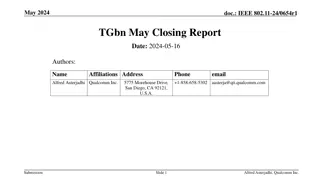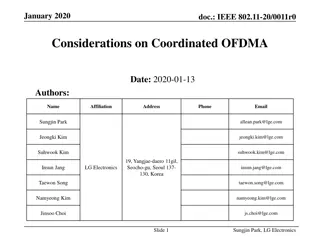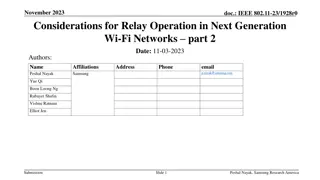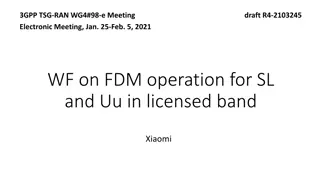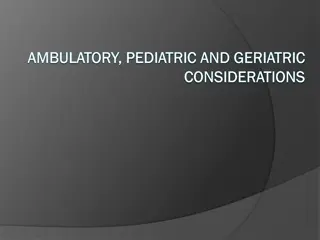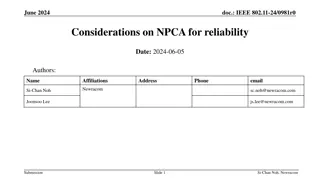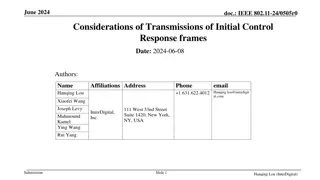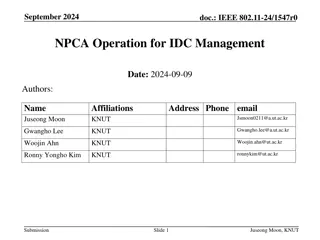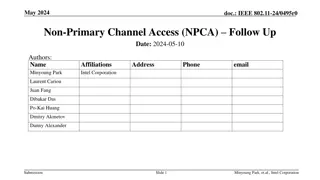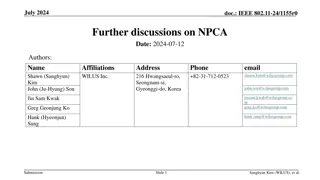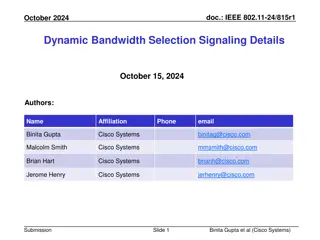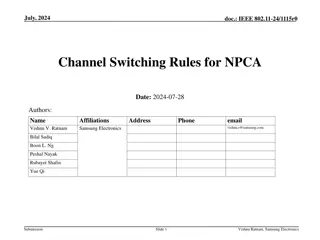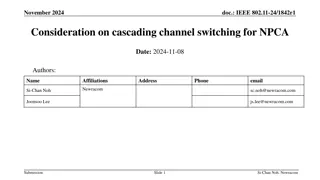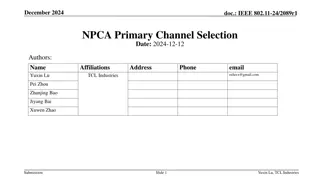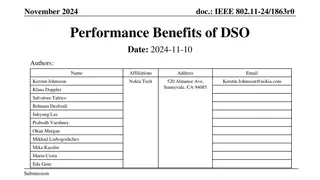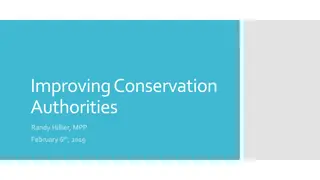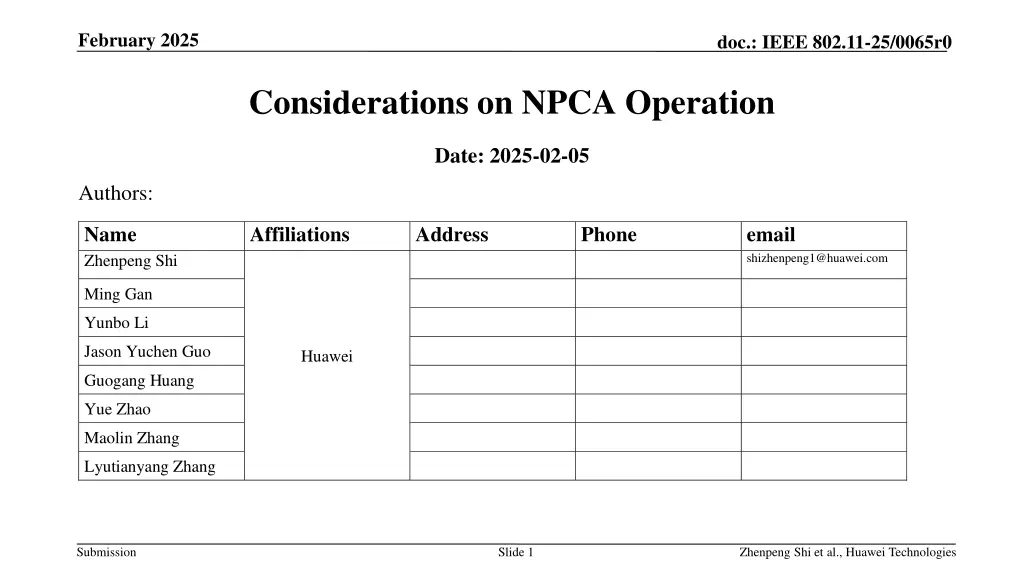
Enhancing NPChannel Access Efficiency in IEEE 802.11 Networks
Explore considerations and solutions for improving Non-primary channel access (NPCA) in IEEE 802.11 networks. Discussions include NPCA operation, primary channel settings, update mechanisms, and coordination among Access Points (APs) for better NPCA efficiency.
Download Presentation

Please find below an Image/Link to download the presentation.
The content on the website is provided AS IS for your information and personal use only. It may not be sold, licensed, or shared on other websites without obtaining consent from the author. If you encounter any issues during the download, it is possible that the publisher has removed the file from their server.
You are allowed to download the files provided on this website for personal or commercial use, subject to the condition that they are used lawfully. All files are the property of their respective owners.
The content on the website is provided AS IS for your information and personal use only. It may not be sold, licensed, or shared on other websites without obtaining consent from the author.
E N D
Presentation Transcript
February 2025 doc.: IEEE 802.11-25/0065r0 Considerations on NPCA Operation Date: 2025-02-05 Authors: Name Zhenpeng Shi Affiliations Address Phone email shizhenpeng1@huawei.com Ming Gan Yunbo Li Jason Yuchen Guo Huawei Guogang Huang Yue Zhao Maolin Zhang Lyutianyang Zhang Submission Slide 1 Zhenpeng Shi et al., Huawei Technologies
February 2025 doc.: IEEE 802.11-25/0065r0 Introduction Non-primary channel access (NPCA) allows AP and STA to access non-primary channel while the primary channel is busy due to OBSS traffic [1] Different aspects of NPCA have been widely discussed [2-13] Triggering events Switching time Location of NPCA primary channel NPCA duration Hidden node / different view problem In this contribution, we will further discuss NPCA primary channel update NPCA duration update Submission Slide 2 Zhenpeng Shi et al., Huawei Technologies
February 2025 doc.: IEEE 802.11-25/0065r0 NPCA primary channel setting Problem with AP setting the same NPCH as OBSS AP1 and AP2 have the same NPCA primary channel (NPCH) OBSS3 TXOP triggers both AP1 and AP2 to do NPCA AP1 or AP2 cannot utilize NPCH due to contention NPCA gain is limited AP 1 OBSS2 TXOP NPCA P20 S160 S80 OBSS3 TXOP P80 P20 AP 2 AP 1 AP 2 NPCA P20 S160 AP 3 S80 OBSS3 TXOP P80 P20 Submission Slide 3 Zhenpeng Shi et al., Huawei Technologies
February 2025 doc.: IEEE 802.11-25/0065r0 NPCA primary channel update AP may update its NPCH considering OBSS NPCH, for example AP1 finds its NPCH is occupied by OBSS2 after AP1 is triggered to do NPCA by OBSS3 AP1 s NPCH is the same as (or adjacent to) the NPCH announced by OBSS In this way, AP reduces collision with OBSS on NPCH and gets better NPCA efficiency AP 1 OBSS2 TXOP Initial NPCA P20 S160 Updated NPCA P20 S80 OBSS3 TXOP P80 P20 AP 2 AP 1 AP 2 NPCA P20 S160 AP 3 S80 OBSS3 TXOP P80 P20 Submission Slide 4 Zhenpeng Shi et al., Huawei Technologies
February 2025 doc.: IEEE 802.11-25/0065r0 NPCA primary channel update APs may coordinate on NPCH updating e.g., AP1 and AP2 coordinate to set NPCHs on different 80MHz subchannels on S160 AP1 can request AP2 to update NPCH NPCH coordination can be supported by Multi-AP Coordination framework [15] Additional considerations APs are recommended to coordinate on NPCH setting if they have a common OBSS Since this common OBSS may trigger both APs to do NPCA at the same time Other NPCA parameter setting can also be coordinated, e.g., NPCA bandwidth APs are recommended to set gaps (e.g., 20MHz) during NPCA transmission to avoid adjacent channel interference Submission Slide 5 Zhenpeng Shi et al., Huawei Technologies
February 2025 doc.: IEEE 802.11-25/0065r0 NPCA different view problem Different view of OBSS TXOP length [10] AP s and STA s NPCA may be triggered by different OBSS TXOP > different NPCA duration One existing solution: all STAs follow AP s view e.g., STA updates NPCA duration based on AP s NPCA duration in ICF/ICR OBSS1 OBSS2 P80 NAV set by OBSS1 (AP & STA1) STA2 STA1 AP P80 NAV set by OBSS2 (STA2) STA3 P80 NAV set by OBSS3 (STA3) OBSS3 Submission Slide 6 Zhenpeng Shi et al., Huawei Technologies
February 2025 doc.: IEEE 802.11-25/0065r0 Problem with following AP s view In some cases, AP may be better off updating NPCA duration based on STA s view For example When AP switches back to PCH at T1, AP cannot transmit due to OBSS2 s ongoing TXOP If AP was still on PCH, its NAV should have been updated by OBSS2 NAV AP can stay on NPCH until OBSS2 NAV ends (T2), if it does not intend to interference with OBSS2 T1 OBSS1 P80 STA1 NAV set by OBSS1 (AP & STA1) AP STA2 P80 NAV set by OBSS2 (STA2) T2 OBSS2 Submission Slide 7 Zhenpeng Shi et al., Huawei Technologies
February 2025 doc.: IEEE 802.11-25/0065r0 NPCA duration update AP and STAs indicate NPCA duration in ICF/ICR NPCA duration is based on NAV set by the OBSS that triggers AP/STA s NPCA AP may update its NPCA duration based on associated STA s NPCA duration Additionally, AP and STAs can indicate OBSS BSS color i.e., BSS color of the OBSS that triggers AP/STA s NPCA AP can use this to determine if OBSS viewed by STA will also affect AP itself AP is recommended to update if STA indicates a longer NPCA duration and OBSS BSS color known by AP STAs switch back to PCH based on AP s NPCA duration e.g., if AP updates NPCA duration based on STA2 s view, STA1 also follows updated NPCA duration Optional for STAs to indicate NPCA duration if they have the same view of OBSS as AP Submission Slide 8 Zhenpeng Shi et al., Huawei Technologies
February 2025 doc.: IEEE 802.11-25/0065r0 NPCA duration update APs initial NPCA duration end APs updated NPCA duration end AP updates NPCA duration based on STA2s reported info OBSS1 S80 ICR BA AP STA1 P80 OBSS 1 TXOP AP STA2 indicates NPCA duration and OBSS 2 BSS color STA2 ICF UL PPDU S80 STA2 OBSS2 OBSS 2 TXOP P80 Example of AP updating NPCA duration: AP updates NPCA duration based on NPCA duration indicated by STA2 in ICF. Updated NPCA duration is indicated in AP s ICR. Submission Slide 9 Zhenpeng Shi et al., Huawei Technologies
February 2025 doc.: IEEE 802.11-25/0065r0 Conclusion In this contribution, we have discussed some problematic NPCA scenarios, including APs in OBSS set the same NPCA primary channel AP and STAs have different view of OBSS TXOP length To improve NPCA efficiency, we propose AP may update NPCA primary channel considering OBSS NPCA primary channel AP may update NPCA duration based on STA s reported information e.g., STA s NPCA duration and BSS color of the OBSS that triggers STA to do NPCA Submission Slide 10 Zhenpeng Shi et al., Huawei Technologies
February 2025 doc.: IEEE 802.11-25/0065r0 References 1. 2. 3. 4. 5. 6. 7. 8. 9. 10. 11-24-1155-00-00bn-further-discussions-on-npca, Sanghyun Kim 11. 11-24-1218-01-00bn-npca-next-level-discussions, Gaurang Naik 12. 11-24-1259-02-00bn-sp-based-non-primary-channel-access-follow-up, Yue Zhao 13. 11-24-1563-02-00bn-npca-follow-up, Liwen Chu 14. 11-24-1596-01-00bn-consideration-of-map-coordination-on-npca-channel, Yan Li 15. 11-24-1838-00-00bn-considerations-on-coordinated-npca, Mahmoud Hasabelnaby 11-24-0209-06-00bn-specification-framework-for-tgbn, Ross Jian Yu 11-23-2005-01-00bn-non-primary-channel-access-npca, Minyoung Park 11-24-0486-01-00bn-some-considerations-on-non-primary-channel-access, Ming Gan 11-24-0803-01-00bn-the-switching-time-in-npca, Yunbo Li 11-24-1077-00-00bn-discussions-on-non-primary-channel-access, Jason Yuchen Guo 11-24-1093-03-00bn-special-scenarios-in-non-primary-channel-access, Sindhu Verma 11-24-1104-03-00bn-some-details-on-npca, Seongho Byeon 11-24-1115-01-00bn-channel-switching-rules-for-npca, Vishnu Ratnam 11-24-1125-01-00bn-considerations-on-switching-for-npca, Dongju Cha Submission Slide 11 Zhenpeng Shi et al., Huawei Technologies

